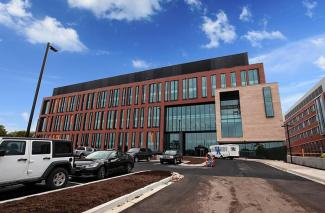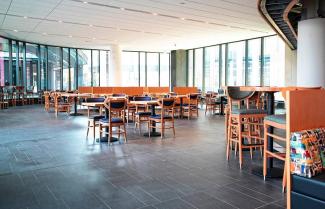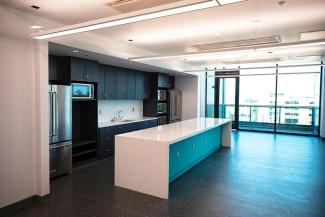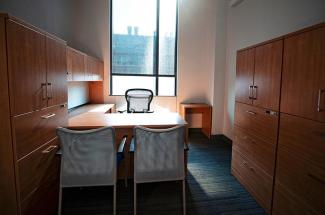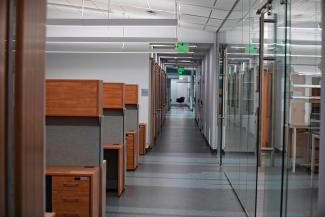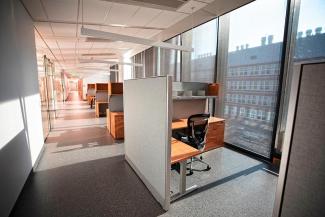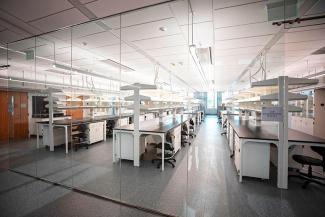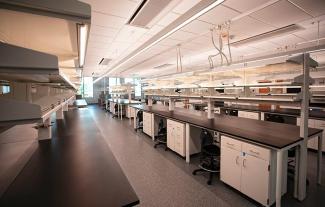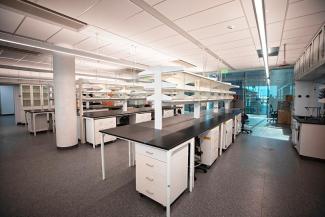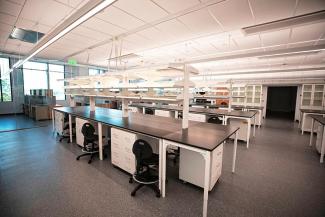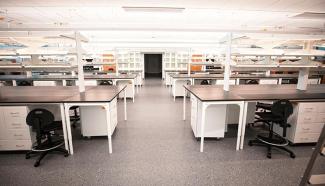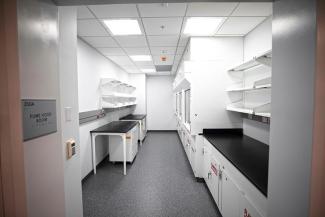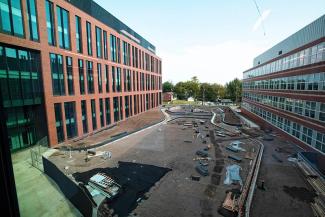This facility enables multidisciplinary research teams—basic biomedical research, health services, public health, behavioral sciences, bioinformatics and big data, economics and engineering—to work together to develop solutions to these complex problems and help Kentuckians live healthier lives.

HKRB Healthy Kentucky Research Building
What health disparities are we targeting? Cancer, Diabetes & Obesity, Cardiovascular Diseases & Stroke, Substance Use Disorder
New Research Building Grand Opening
Watch the September 21, 2018, press conference and see photos from the event and tour.
UK researchers are working to turn the tide of health disparities
Kentucky ranked 2nd in cancer deaths in 2022.
In FY23, UK spent $71 million researching cancer-related treatment and prevention.
Kentucky ranked 8th in heart disease deaths and 16th in strokes in 2022.
In FY 23, UK spent $27 million researching treatment for cardiovascular diseases including heart disease, heart failure, aortic aneurysms and stroke.
Kentucky ranked 7th in overdose deaths in 2022.
In FY23, UK spent $74 million researching prevention and treatment for opioid use disorder and other substance use disorders.
Kentucky ranked 9th in diabetes-related deaths in 2022.
In FY23, UK spent $49 million researching treatment and prevention for diabetes and obesity.
Source: CDC National Center for Health Statistics
How many researchers?
92 faculty principal investigators (PIs) who lead federally funded research projects and 250 undergraduate, graduate and postdoctoral scholars who work on federally funded research projects
24 new faculty and 75 new support staff
HKRB Timeline
Groundbreaking & Funding
In 2015 UK broke ground for this $265 million building (half of the funding from the state of Kentucky; half from university resources, including private gifts). In 2018, legislative leaders designated an additional $40 million in bonds toward UK’s work to turn the tide of health disparities. In 2019, UK received a $6 million NIH C06 construction grant to create an innovative first-floor vascular research lab to boost leading-edge work in the Saha Cardiovascular Research Center, the Department of Biomedical Engineering and the Sanders-Brown Center for Aging.
Phase I
Opened September 2018, Phase 1 included some of the basement and floor 1, and all of floors 2 and 3.
Phase II
2020: Basement, floors 4 and 5.
Phase III
2022: First floor auditorium, conference room, labs and offices, floor 6.
Overall Design
- Corridor from BBSRB to new building on 2nd floor
- Behavioral and computational research suites on 2nd floor
- Offices and personnel carrels on floors 2, 3 & 4
- 300,000 square feet
- 6 floors of biomedical laboratories (96 benches), 3 floors of researchers in Connector Building
- Modern animal facility in basement
- Core facilities with imaging, behavioral & metabolic shared equipment for all health areas
- Combined underground loading dock to service buildings in this complex
- Green-roof over basement connecting new building to BBSRB with Wi-Fi capability
- Glass walls & large windows for natural lighting & an open environment
- Most floors have 3 neighborhoods (6 laboratory benches in each neighborhood)
- Benches are flanked by procedure rooms with specialized equipment
- Linear equipment hall down the center of each lab floor to improve efficiency of operations
- Faculty offices flank corners of each neighborhood
Auditorium, Meeting Spaces and Amenities
- 100-seat capacity auditorium that opens to 1st-floor atrium
- 2nd-floor conference rooms & additional collaborative spaces on each floor
- Starbucks & indoor bike room for campus community
This building is a precious resource and a vehicle for the University of Kentucky to reduce the health disparities that most impact Kentucky. This $265 million building (funded half from the state of Kentucky, half from university resources, including private gifts) opened September 21, 2018. By investing in this state-of-the-art research facility, the University of Kentucky is investing in the health of citizens of the Commonwealth.
The design of this modern research facility embodies a lifestyle that reduces health disparities, including a healthy food choice restaurant, a room to house bicycles for travel to and from the facility, and prominent staircases to encourage physical activity. Within the laboratories, the design and focus comes with a specific scientific underpinning. Much of discovery today, whether at the cellular or community level, happens at the intersection of disciplines. This facility is designed to foster discovery and collaboration so that what happens in the labs and in the course of basic research can be translated to answers and solutions at the community level.
To foster collaboration, laboratories within the facility are designed as neighborhoods to not only promote communication between researchers, but to create synergy between disciplines. Basic researchers addressing fundamental issues that contribute to chronic diseases will work side-by-side with researchers who approach these intractable problems from a totally different perspective. By placing people, who are working on the same problem—say, cancer—but from different angles (economics, biomedicine, public health), next to each other in a single building facilitates communication and promotes new avenues for problem solving. Through this design, the project will improve the lives of Kentuckians by providing modern space that lends itself to multidisciplinary research that is needed to address Kentucky’s entrenched health problems.
While each of these major diseases influence citizens across the Commonwealth, they are of immense concern to our citizens residing in rural Appalachia, a region with some of the most pronounced rates of chronic diseases in the country. Rates of death from cancer in the United States dropped by 20 percent between 1980 and 2014 (data from the Institute for Health Metrics and Evaluation, University of Washington, released February 2017).
However, these gains were not distributed equally across the country. Clusters of high mortality were found in many states, including Kentucky, West Virginia, Alabama and Alaska. Four main factors drive these disparities: socioeconomic status, access to health care, quality of health care available, and prevalence of risk factors, such as smoking, obesity and lack of physical activity. The Appalachian region of Kentucky experiences a perfect storm of these factors driving disparities. A primary focus of research within the new facility will be determining factors that drive more disease risk and burden in Appalachia, and developing preventive and therapeutic approaches that are optimized to have greater benefit to those living in this region.
The new research facility will be at the heart of modern research facilities all linked together, including the Biomedical Biological Science Research Building (BBSRB) and the Lee T. Todd, Jr. Building (formerly the BioPharm Building). The location of the facility, which will link all three buildings in complex, further fosters collaborative and multidisciplinary research. The connecting conduit building will house the nucleus of translational researchers who bring together all disciplines.
The real power of research is realized in bringing different groups of experts together. Our current experts and top talent recruited to the University of Kentucky, working together in this new faculty, will make important discoveries and that are translated to the community to help Kentuckians live healthier lives.
